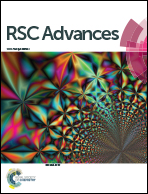Green synthesis of potassium zinc hexacyanoferrate nanocubes and their potential application in photocatalytic degradation of organic dyes
Abstract
A novel green route was used to synthesize potassium zinc hexacyanoferrate (K2Zn3[Fe(CN)6]2·9H2O) (KZnHCF) nanocubes using Sapindus mukorossi as a natural surfactant and water as the solvent. The synthesized nanoparticles were characterized by powder X-ray diffraction (PXRD), scanning electron microscopy (SEM), transmission electron microscopy (TEM), Fourier Transform Infrared Spectroscopy (FTIR), thermogravimetric techniques and BET surface area analysis. KZnHCF nanoparticles were investigated for their effect on the photocatalytic degradation of two synthetic dyes namely Eriochrome Black T (EBT) and Malachite Green (MG). The effect of process parameters like pH, temperature, KZnHCF dose and concentration of the dye on KZnHCF mediated degradation of both dyes was also investigated. Under optimized conditions, KZnHCF resulted in 94.15% degradation of MG followed by 76.13% EBT degradation.


 Please wait while we load your content...
Please wait while we load your content...